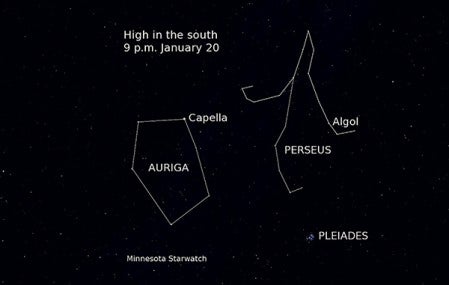Minnesota Star Watch: Planets brighten skies
Published 8:07 am Sunday, December 28, 2014
 By Deane Morrison
By Deane Morrison
We’ll be treated to a long, slow approach between the two brightest planets in 2015, a year that gets off to a running start with a full moon.
January’s “wolf” moon reaches fullness at 10:53 p.m. on the fourth. Its name comes from the howling of hungry wolves outside Indian villages in the deep snow and cold. This moon takes a high trajectory across the night sky, a path that contrasts sharply with that of the sun’s daytime path because in winter—especially early winter—the Northern Hemisphere tilts away from the sun and toward the full moon.
Also on the fourth, Earth reaches perihelion, the closest point to the sun in its orbit. On that day, we’ll swoop to a mere 91.4 million miles from our parent star.
In the predawn sky, Saturn is climbing in the southeast, close to the claws of Scorpius. As the month goes by, the red star Antares, the scorpion’s heart, comes up below the ringed planet and this pair shines as the two brightest points above the south-southeastern horizon. On the 16th, a waning crescent moon rises next to Saturn.
The middle third of January has several moonless hours each evening, so this is a good time to go out and find some lesser-known constellations, such as Perseus. Start with the bright, multicolored star Capella in Auriga, the charioteer. A five-sided constellation, Auriga is high in the south, above the hourglass form of Orion. Just west of Capella, use a star chart to make out the scraggly form of Perseus.
Perseus’s second brightest star, Algol, the Demon Star, represents the winking eye of Medusa, the snake-haired monster whose head Perseus carries. The winking is caused by the orbit of two stars in the Algol stellar system. In a cycle lasting not quite three days, the dimmer passes in front of the brighter and partially eclipses it from our point of view, causing a 10-hour dip in Algol’s brightness.
Jupiter rises earlier each night, following the knot of bright winter constellations into the sky. Meanwhile, in the west, Venus is coming into its own as an evening star. A young moon joins the brilliant planet on the 21st; if you look about 45 minutes after sunset you may catch Mercury below the moon, all but lost in the sun’s glare.
Venus and Jupiter are drawing closer, heading for a close encounter above the sunset horizon in June. But first, Venus has a rendezvous next month with Mars, which clings stubbornly to its patch of southwestern sky, resisting the inevitable tumble into the sunset that happens after Earth leaves it behind. The Red Planet gets this power from its great speed, which moves it resolutely eastward against the background of stars. It easily outstrips the more distant Jupiter and Saturn, neither of whose staying power can hold a candle to Mars’.
If you’re in the Twin Cities any time from now through May, check out the “Eyes on the Universe” exhibit at the University of Minnesota’s Bell Museum and learn how researchers study the moon, the Andromeda galaxy and beyond. Also, its hands-on, kid-friendly companion exhibit, “A View from Space,” turns the observer’s eye back to Earth through satellite imagery.
The University of Minnesota offers public viewings of the night sky at its Duluth and Twin Cities campuses. For more information and viewing schedules, see:
Duluth, Marshall W. Alworth Planetarium: www.d.umn.edu/planet
Twin Cities, Minnesota Institute for Astrophysics (during fall and spring semesters): www.astro.umn.edu/outreach/pubnight.
Check out the astronomy programs at the University of Minnesota’s Bell Museum ExploraDome: www.bellmuseum.umn.edu/ForGroups/ExploraDome/index.htm.
Contact: Deane Morrison, University Relations, (612) 624-2346,morri029@umn.edu
Find U of M astronomers and links to the world of astronomy athttp://www.astro.umn.edu.




